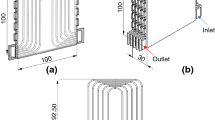Abstract
Improving the heat transfer coefficient of working fluids is essential for achieving the best performance of manufacturing systems. As a replacement of conventional working fluids, nanofluids have a high potential for improving this heat transfer coefficient. However, nanofluids are seldom implemented in actual systems, and several factors should be considered before actual application. Accordingly, this study investigated the thermophysical properties and heat transfer rate of CuO/deionized water nanofluid with and without sodium dodecyl sulfate (SDS) surfactants. Three different volumetric concentrations of the nanofluid were prepared using a two-step preparation method. The experimental steps were divided into two phases: static and dynamic. In these experiments, the thermophysical properties of the prepared nanofluids and the heat transfer coefficient were measured using an apparatus designed based on an actual heat exchanger for a lithium ion polymer battery compartment. The effects of flow rate and surfactants on the heat transfer rate of the nanofluids with varying volumetric concentrations of 0.08%, 0.16%, and 0.40% were analyzed. The results indicate that the heat transfer rate increases considerably as the flow rate increases from 0.5 L/min to 1.2 L/min and with the presence of surfactants. The highest heat transfer rate was obtained at a 0.40% volumetric concentration of CuO/deionized water nanofluid with SDS surfactant.








Similar content being viewed by others
References
Zangeneh A, Vatani A, Fakhroeian Z, Peyghambarzadeh SM (2016) Experimental study of forced convection and subcooled flow boiling heat transfer in a vertical annulus using different novel functionalized ZnO nanoparticles. Appl Therm Eng 109:789–802. https://doi.org/10.1016/j.applthermaleng.2016.08.056
Shahrul IM, Mahbubul IM, Saidur R, Sabri MFM (2016) Experimental investigation on Al2O3-W, SiO2-W and ZnO-W nanofluids and their application in a shell and tube heat exchanger. Int J Heat Mass Transf 97:547–558. https://doi.org/10.1016/j.ijheatmasstransfer.2016.02.016
Li Y, Tung S, Schneider E, Xi S (2009) A review on development of nanofluid preparation and characterization. Powder Technol 196:89–101. https://doi.org/10.1016/j.powtec.2009.07.025
Gupta M, Arora N, Kumar R et al (2014) A comprehensive review of experimental investigations of forced convective heat transfer characteristics for various nanofluids. Int J Mech Mater Eng 9(1):11
Wang XQ, Mujumdar AS (2007) Heat transfer characteristics of nanofluids: a review. Int J Therm Sci 46:1–19. https://doi.org/10.1016/j.ijthermalsci.2006.06.010
Chang M, Liu H, Tai CY (2011) Preparation of copper oxide nanoparticles and its application in nanofluid. Powder Technol 207:378–386. https://doi.org/10.1016/j.powtec.2010.11.022
Gangadevi R, Vinayagam BK, Senthilraja S (2018) Effects of sonication time and temperature on thermal conductivity of CuO/water and Al2O3/water nanofluids with and without surfactant. Mater Today Proc 5:9004–9011. https://doi.org/10.1016/j.matpr.2017.12.347
Saidur R, Leong KY, Mohammad HA (2011) A review on applications and challenges of nanofluids. Renew Sust Energ Rev 15:1646–1668. https://doi.org/10.1016/j.rser.2010.11.035
Abasi B, Dehkordi F, Abdollahi A (2018) Experimental investigation toward obtaining the effect of interfacial solid- liquid interaction and base fluid type on the thermal conductivity of CuO- loaded nanofluids. Int Commun Heat Mass Transfer 97:151–162. https://doi.org/10.1016/j.icheatmasstransfer.2018.08.001
Lotfizadehdehkordi B, Kazi SN, Hamdi M et al (2013) Investigation of viscosity and thermal conductivity of alumina nanofluids with addition of SDBS. Heat Mass Transf:1109–1115. https://doi.org/10.1007/s00231-013-1153-8
Chakraborty S, Saha SK, Pandey JC, Das S (2011) Experimental characterization of concentration of nanofluid by ultrasonic technique. Powder Technol 210:304–307. https://doi.org/10.1016/j.powtec.2011.03.035
Hossein M, Darvanjooghi K, Esfahany MN (2016) Experimental investigation of the effect of nanoparticle size on thermal conductivity of in-situ prepared silica – ethanol nanofluid. Int Commun Heat Mass Transfer 77:148–154. https://doi.org/10.1016/j.icheatmasstransfer.2016.08.001
Nanofluid M (2010) Enhanced thermal conductivity of nanofluids: a state-of-the-art review. Microfluid Nanofluid 8:145–170. https://doi.org/10.1007/s10404-009-0524-4
Afrand M (2017) Experimental study on thermal conductivity of ethylene glycol containing hybrid nano-additives and development of a new correlation. Appl Therm Eng 110:1111–1119. https://doi.org/10.1016/j.applthermaleng.2016.09.024
Zakaria I, Azmi WH, Mohamed WANW et al (2015) Experimental investigation of thermal conductivity and electrical conductivity of Al2O3 nanofluid in water - ethylene glycol mixture for proton exchange membrane fuel cell application. Heat Mass Transf 61:61–68. https://doi.org/10.1016/j.icheatmasstransfer.2014.12.015
Pak BC, Cho YI (1998) Hydrodynamic and heat transfer study of dispersed fluids with submicron metallic oxide particles. Exp Heat Transfer 11:151–170. https://doi.org/10.1080/08916159808946559
Yu W, Choi SUS (2003) The role of interfacial layers in the enhanced thermal conductivity of nanofluids: a renovated Maxwell model. J Nanopart Res 5:167–171
Xuan Y, Roetzel W (2000) Conceptions for heat transfer correlation of nanofluids. Int J Heat Mass Transf 43:3701–3707
Brady JF (1984) The Einstein viscosity correction in n dimensions. Int J Multiphase Flow 10:113–114
Khair AS (2006) The ‘Einstein correction’ to the bulk viscosity in n dimensions. J Colloid Interface Sci 302:702–703. https://doi.org/10.1016/j.jcis.2006.07.076
Pandey SD, Nema VK (2012) Experimental analysis of heat transfer and friction factor of nanofluid as a coolant in a corrugated plate heat exchanger. Exp Thermal Fluid Sci 38:248–256. https://doi.org/10.1016/j.expthermflusci.2011.12.013
Leong KY, Saidur R, Khairulmaini M et al (2012) Heat transfer and entropy analysis of three different types of heat exchangers operated with nanofluids. Int Commun Heat Mass Transfer 39:838–843. https://doi.org/10.1016/j.icheatmasstransfer.2012.04.003
Ho CJ, Chen WC (2013) An experimental study on thermal performance of Al2O3/water nanofluid in a minichannel heat sink. Appl Therm Eng 50:516–522. https://doi.org/10.1016/j.applthermaleng.2012.07.037
Acknowledgements
The authors thank UniMAP University (Malaysia) for providing laboratory facilities and for assistance with the equipment. Furthermore, the staff at the Institute of Nano Electronic Engineering, Universiti Malaysia Perlis (Malaysia) are graciously acknowledged for their productive discussions and input to the research.
Author information
Authors and Affiliations
Corresponding author
Additional information
Publisher’s note
Springer Nature remains neutral with regard to jurisdictional claims in published maps and institutional affiliations.
Rights and permissions
About this article
Cite this article
Bin-Abdun, N.A., Razlan, Z.M., Bakar, S.A. et al. Heat transfer improvement in simulated small battery compartment using metal oxide (CuO)/deionized water nanofluid. Heat Mass Transfer 56, 399–406 (2020). https://doi.org/10.1007/s00231-019-02719-6
Received:
Accepted:
Published:
Issue Date:
DOI: https://doi.org/10.1007/s00231-019-02719-6




